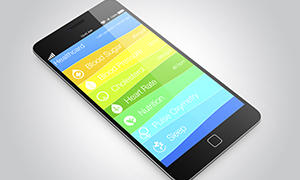Mobile Phone Diagnostic for COVID-19
Smartphones are Getting Smarter: Detecting COVID-19 with Your Mobile Phone
It all started with a curiosity, a COVID-19 pandemic, and a cat toy.
A graduate student in 2015, Kevin Yehl, had a basic question. What would happen if an enzyme and its substrate (the thing enzyme proteins bind to) were frozen on a surface? Yehl worked with Emory chemistry professor, Khalid Salaita, PhD, and the two were in for a surprise. Rather than the expected outcome of increased enzyme reactivity, the experiment led to the discovery of rolling DNA motors that could carry and move small particles around on a surface.
“When we started, it was purely out of curiosity. We had no interest at all in applications,” said Salaita. “It was really intended to be a curiosity project where we simply wanted to find out what would happen.”

Khalid Salaita, PhD
When Salaita published the motor discovery in Nature in 2016, an editor challenged them to create a new application for the science that was not currently available. Then, in 2020, COVID-19 hit. For the science community, the pandemic meant all hands on deck, and Salaita and his team pivoted their research toward COVID-19 diagnoses.
The Salaita lab reverted to Zoom during lockdown but continued their work. Graduate student Selma Piranej remembers going back to the drawing board to figure out a COVID-19 application for the lab’s research.
“In this case, we wanted to focus on detecting proteins and viral proteins, so we shifted and programmed the motors to try to think about how we can get them to detect viral proteins,” Piranej said.
Using sticky patches attached to the motor and a surface, Salaita and his team created a system that freezes the motor when a virus is present. If the particles continue to move, then a virus is not present. But detecting movement that small required a microscope and in-person lab work.
Yehl had a hunch that a plastic lens would be good enough to use as a microscope. He walked down to the Emory Village CVS where he found a laser pointer cat toy that he purchased and brought back to the lab. Disassembling the toy, he extracted the lens and taped it to his phone camera. The result was yet another surprise: The home-built setup worked, detecting moving particles just like a microscope.

Mobile Phone
It was the initial version of what is now the mobile phone diagnostic for COVID-19. In the early days of the technology, OTT evaluated its commercial potential and pursued appropriate IP protection. Catherine Murari-Kanti, a senior licensing associate at OTT, handled the case file for the technology and created a commercialization evaluation report for it - a standard process for technology going through OTT. “This report takes into consideration the technology summary, market research and analysis, prior art search, and technology-related due diligence,” Murari-Kanti said. “We decided to protect this technology and have filed a full patent. The lab continues to develop the technology.”
Salaita and his team envision the mobile phone diagnostic expanding beyond COVID-19 to viruses such as influenza or RSV.
“One of the neat things about our system is we can detect many viruses and many viruses in a single shot,” explained Salaita. “So, we imagine some point in the future where you can create a whole library of motors, each sensitive to different kinds of virus.”
Asked what the most gratifying part of the process has been, Salaita didn’t hesitate. “Emory undergraduates and graduate students,” he responded instantly. “They really push the project from inception all the way to these early stages of commercialization. So they've been a delight to work with - very smart, very motivated and creative, and they always blow my mind with the amount of energy and creativity they bring with them.”
And for Yehl, the grad student whose question started it all?
“No graduate student wants to see their project die. This [project] has really taken a life of its own,” Yehl said. “It has been very successful and that’s just really gratifying. I think it goes to show what vision, creativity and hard work can produce.”
Read our technology brief
— Chaya Tong